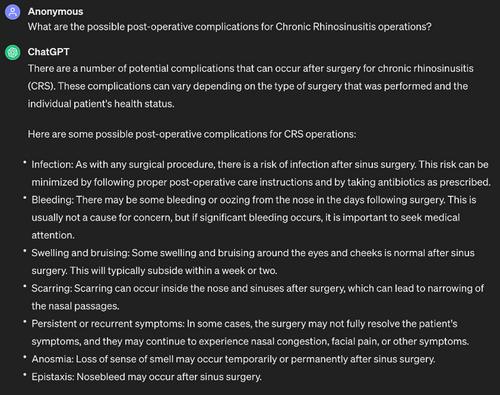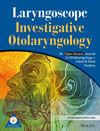Search for medical information for chronic rhinosinusitis through an artificial intelligence ChatBot
Abstract
Objectives
Artificial intelligence is evolving and significantly impacting health care, promising to transform access to medical information. With the rise of medical misinformation and frequent internet searches for health-related advice, there is a growing demand for reliable patient information. This study assesses the effectiveness of ChatGPT in providing information and treatment options for chronic rhinosinusitis (CRS).
Methods
Six inputs were entered into ChatGPT regarding the definition, prevalence, causes, symptoms, treatment options, and postoperative complications of CRS. International Consensus Statement on Allergy and Rhinology guidelines for Rhinosinusitis was the gold standard for evaluating the answers. The inputs were categorized into three categories and Flesch–Kincaid readability, ANOVA and trend analysis tests were used to assess them.
Results
Although some discrepancies were found regarding CRS, ChatGPT's answers were largely in line with existing literature. Mean Flesch Reading Ease, Flesch–Kincaid Grade Level and passive voice percentage were (40.7%, 12.15%, 22.5%) for basic information and prevalence category, (47.5%, 11.2%, 11.1%) for causes and symptoms category, (33.05%, 13.05%, 22.25%) for treatment and complications, and (40.42%, 12.13%, 18.62%) across all categories. ANOVA indicated no statistically significant differences in readability across the categories (p-values: Flesch Reading Ease = 0.385, Flesch–Kincaid Grade Level = 0.555, Passive Sentences = 0.601). Trend analysis revealed readability varied slightly, with a general increase in complexity.
Conclusion
ChatGPT is a developing tool potentially useful for patients and medical professionals to access medical information. However, caution is advised as its answers may not be fully accurate compared to clinical guidelines or suitable for patients with varying educational backgrounds.
Level of evidence: 4.


 求助内容:
求助内容: 应助结果提醒方式:
应助结果提醒方式:


